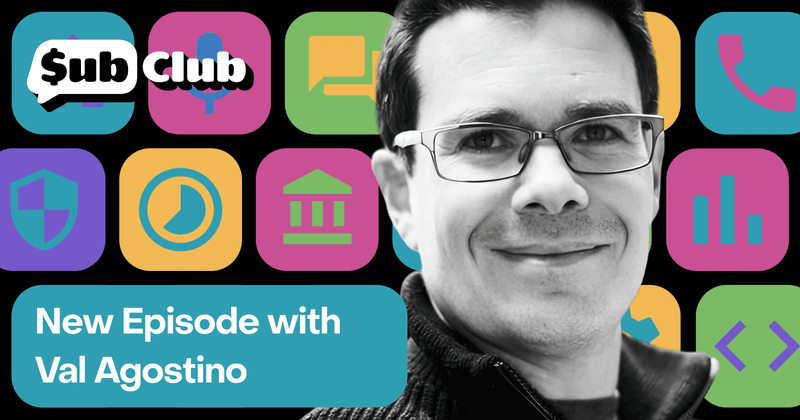“Pick a problem that you want to work on for 10 years, even if it were to fail” — Val Agostino, Monarch Money
Time, talent, and money will get you far — but to ride the downs as well as the ups, you need passion.

Building a successful subscription app business requires a lot of things: time, talent, and money, to name a few. But one of the ingredients for success that’s often downplayed or overlooked is passion. Let’s face it: it’s not easy to create digital products from scratch. And as the market becomes increasingly crowded, the bar for winning and retaining customers is higher than ever.
Val Agostino, a seasoned Internet entrepreneur with over 25 years of experience, knows better than anyone how passion for problem-solving makes all the difference. This week on the Sub Club podcast, we chatted with Val about his experience working on not one but two beloved financial health apps, and what it takes to stick it out for the long haul.
Choose your customer wisely
When building an app business, you have a choice to make: should your product be ad-supported or subscription-based? Obviously there are revenue implications for this question, but there’s a deeper issue — what you’re really choosing is who your customer will be. If you opt for an ad-supported model, your real customer isn’t your app users; it’s the advertisers paying you to show their ads. And according to Val, “[this] ultimately creates a shitty product because you’re constantly trying to drive more and more ad revenue out of it… at the expense of the user experience.”
This is unfortunately what happened to Mint. The beloved financial health app was ad-supported from the beginning, and over time, this led to a degraded user experience. “This was a constant tension at Mint,” Val said. “How many offers can we get in front of a user per session? How do we get them to take things? It was a constant battle between the revenue team and the product team.” After Mint was acquired and ultimately shut down last month, it created an opportunity for the Monarch team to win over former Mint users with a more user-centric, subscription-based product.
Raising the bar for MVP
We’ve all heard the startup mantras “fail fast” and “just ship it,” and to an extent, they’re useful. You definitely don’t want to stay in the idea and development phases forever! But to stand out in your industry, Val emphasizes the importance of truly understanding your customers’ needs before shipping your app. “The classic thing is get one version out there: build it, ship it, look at the data, figure out what people like and what they don’t like… rinse and repeat. And that whole thing took you three months. And now you’ve got to do another three months. And finally to get where you’re trying to get, maybe you spend nine months on three releases. Whereas if you can do more upfront iteration, it might take you longer, but the end result is better.”
To cut down on this iteration time, the Monarch team created clickable prototypes of requested features and asked customers, “Would this new feature solve your problem?” By getting this kind of customer feedback before actually shipping a new version, the Monarch team was able to release a better product in fewer iterations.
Going beyond app features
To build a truly sticky app, you need to solve some customer pain point in a meaningful way. And to do that, you need to understand what those pain points are — not just in terms of requested app features, but the emotional reasons behind them. For Val and his team, the Jobs to Be Done framework and the Five Whys (asking “why” five times until you arrive at the root reason) are extremely helpful for finding this deeper product-market fit.
Take Monarch’s new “due dates on bills” feature for example. Why do customers want to know when their upcoming bills are due? It turns out, this is a really helpful feature for users with ADHD (who need to see all of their upcoming expenses in one place). But a secondary benefit for users was the ability to know for sure that they have enough cash in the bank to cover their upcoming bills. The real “why” of this feature is peace of mind.
When you know the emotional “why” behind a feature request, not only can you build a robust feature that addresses that need, but you may be able to take it further and start adding features customers wouldn’t even think to ask for.
For Val, the “why” of building a better financial health app is part personal, part passion. As an app founder, he’s gone through phases when money was tight and he and his family benefited from financial planning tools. But more than that, he knows he’s not alone. “Finances are the number one source of stress in American families… [there’s a] real impact these types of things have on people’s lives.”
You might also like
- Blog post
Scaling UA without wrecking your conversion rate: A Meta campaign playbook
A structured testing system helped one app lower cost-per-trial while targeting its most profitable users
- Blog post
Gamification in apps: A complete guide to using motivation to drive real value
Why streaks fall short and 11 apps getting gamification right
- Blog post
Apple’s June 2025 EU update: one entitlement, three fees, and CTF’s 2026 sunset
What apps in the EU should do after Apple’s DMA tweak.

